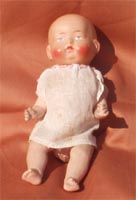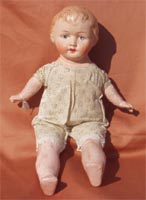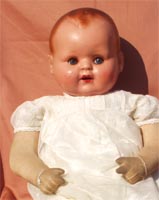History of papier mache dolls
Papier mache dolls have been around for a few hundred years. They can be in the form of puppets, including hand, string and larger than life size, baby dolls, fashion dolls, boy dolls and the creche dolls made for the Christmas crib scenes. In doll language it is material of the head which defines the whole doll so a papier-mache doll need only have a head that is actually made from papier mache and the body can be made of cloth, leather, wood or composition.
Papier mache dolls come under the collective term of composition which also includes celluloid and numerous others. It is sometimes hard to know when a doll is made of papier mache or composition but in general terms papier mache dolls are basically made of paper pulp plus other substances whilst composition dolls are made from wood pulp plus other substances. Confusion still reigns as some dolls’ bodies are referred to as composition when in fact they are made from papier mache.
In a late 19th century dictionary papier mache is defined as “a tough plastic material made from paper pulp containing an admixture of size, paste, oil, resin or other substances or from
sheets of paper glued and pressed together”.
One of the first references to papier mache dolls can be found in the Histoire des Jouets et Jeux D’enfants by Fournier where it seems that from the time of Francis 1 of France (ca.1540) doll makers always used a mixture of clays, paper and plaster called carton-pierre (literally stone pasteboard). This mixture was worked together and pressed into molds, backed by coarse paper and dried by steam. By the 18th century German communities, including Sonneberg and Nurnberg, were making papier mache dolls alongside the towns of France.
Around 1810 it was discovered that papier-mache dolls could be mass produced cheaply in moulds by a pressure process. As the dolls were mainly made of waste materials they could be produced quite cheaply.
One account of the doll making process states that when released from the molds the papier mache heads were smoothed, the two halves joined with glue and then the whole was painted with a mixture of limewash and ground colours and allowed to dry. The eyes, lips and hair were then painted and a coat of varnish applied. Whilst the cheeks were still sticky they were painted with fine carmine or Florentine lacquer. Sometimes, to save money, the coat of varnish was left off. This made the dolls head almost impossible to clean.
By the 1820’s papier mache heads were used extensively on a body made of kid leather which had carved wooden limbs. These dolls were known as milliners models or coiffure dolls - in fact an early form of fashion doll and by the mid 19th century the papier mache dolls had reached the height of their popularity.
In 1858 Ludwig Greiner, a famous dollmaker, patented a doll’s head which used white paper, Spanish whiting, rye flour, glue and paste reinforced with linens and muslin.
Around 1870 papier mache began to be used for jointed bodies which were used well into the 20th century.
Below are some examples of early 20th Century papier mache dolls from my own collection:

- Ralph - small baby doll
Ralph
A small baby doll made entirely of papier mache with painted features. His jointed body is held in place with metal springs. He is unmarked so a maker cannot be identified. He is wearing the original shift in which he would have been sold. He was probably made in the 1930's or 40's. At the time he would have been an inexpensive doll.
Jack
A boy doll with the head and lower half of the arms and legs made of papier mache. He has moulded and painted features and his body is cloth stuffed with wood shavings. Again, he is unmarked and made about the 1930's. He is also wearing the underclothes he would have been sold in and would again have been a cheap doll to produce.

- Jack - baby doll

- Elsa - large baby doll
Elsa
A large baby doll with just the head made out of papier mache. Her sleeping eyes are large and made of glass. She is attached to a cloth body. Once again she is unmarked and unidentifed. She was made in the 1930's or 40's. She has been dressed in an old christening gown but may originally have worn a simpler shift or gown.
Soon ceramic and other types of composition heads were to become more popular and the demand for papier-mache heads began to decline.
Papier-mache doll heads could have closed mouths or open mouths with teeth made form bamboo, painted eyes or inserted glass eyes, bald heads with wigs made from mohair or human hair or elaborately moulded hairstyles in the fashions of the day. Sometimes these hairstyles were so involved that they were made from 8-10 part molds all skilfully joined together. The doll’s heads themselves could be attached to wood, cloth, leather, papier-mache or composition bodies.
Many of these charming dolls survive today and make interesting additions to collections whether they are in doll, social history or papier-mache collections.
Further Reading
The Collector's Encyclopedia of Dolls Vol 2 - Elizabeth A., and Evelyn J. Coleman
Collector's History of Dolls - Constance Eileen King
Dolls: A Collector's Guide - Olivia Bristol
Collecting Dolls - Nora Earnshaw
Search for related books

